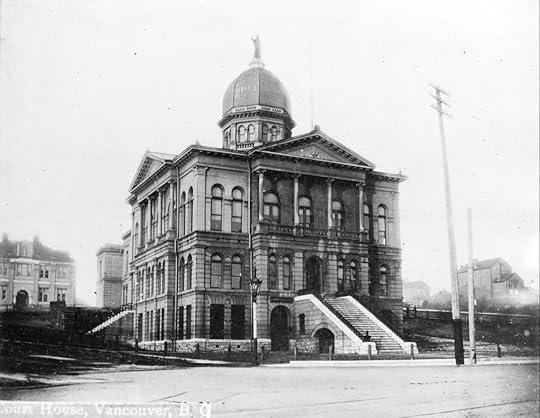Victory Square: what was there before?
Before Victory Square was Victory Square and home to the Cenotaph, it was a happening part of the city known as Government Square, because it was the site of the first provincial courthouse.

The impressive domed building was operational by 1890 and was the first major building outside of Gastown. It was quickly apparent that it was too small for our growing city, and within a few years had a large addition with a grand staircase and portico facing Hastings Street.
 Flack Building and the Courthouse ca.1900. Courtesy Vancouver Archives
Flack Building and the Courthouse ca.1900. Courtesy Vancouver ArchivesBuildings started to spring up around the Courthouse. In 1898, architect William Blackmore (Badminton Hotel, Lord Strathcona Elementary) designed a building for Thomas Flack who had made his fortune in the Klondike and wanted to see an impressive building bear his name.
 The Arcade (corner building on the right), 1898. Courtesy Vancouver Archives
The Arcade (corner building on the right), 1898. Courtesy Vancouver ArchivesFour years earlier, Charles Wickenden, the same architect behind Christ Church Cathedral and the first Vancouver Club, designed the Arcade, a wooden building containing 13 shops, at the corner of Hastings and Cambie. It was gone by 1909, replaced by the fancy Dominion Building, at the time, the tallest building in the British Empire. It stayed that way until Mayor L.D. Taylor financed the Sun Tower as a monument to his newspaper (The World) in 1912.
 Dominion and the Flack Building 1919. Courtesy Vancouver Archives 99.232
Dominion and the Flack Building 1919. Courtesy Vancouver Archives 99.232While Vancouver gained the Sun Tower and the new lawcourts on West Georgia (now the Vancouver Art Gallery), the city lost the original courthouse building–demolished after just 20 years.
The Square, which is actually more of a triangle than a square, is bounded by Hastings , Cambie, Pender and Hamilton. It didn’t remain empty for long. By 1914 it was filled with a military tent, used to recruit soldiers for World War 1. Then in 1917, up went the Evangelistic Tabernacle where the courthouse once stood.
 The Evangelistic Tabernacle under construction in 1917. Courtesy Vancouver Archives
The Evangelistic Tabernacle under construction in 1917. Courtesy Vancouver ArchivesThe church was short lived as well. The Southams, owners of the Province Newspaper, which was housed across the street, donated funds to develop a park on land on the vacant land, which was then renamed Victory Square. By 1924, enough public money had been raised to build the Cenotaph designed by G.L. Sharp. Sharp had the 30-foot Cenotaph constructed from granite from Nelson Island.
The inscription facing Hastings Street reads: “Their name liveth for evermore. Facing Hamilton it says “Is it nothing to you.” And Facing Pender Street: “All ye that pass by.”
 Victory Square 1925, courtesy Vancouver Archives
Victory Square 1925, courtesy Vancouver ArchivesTop photo: Courthouse on Hastings and Cambie, courtesy CVA Bu N13 ca.1893
References: Building the West; Public Art in Vancouver; The Vancouver Book; Vancouver Remembered.
© All rights reserved. Unless otherwise indicated, all blog content copyright Eve Lazarus.




